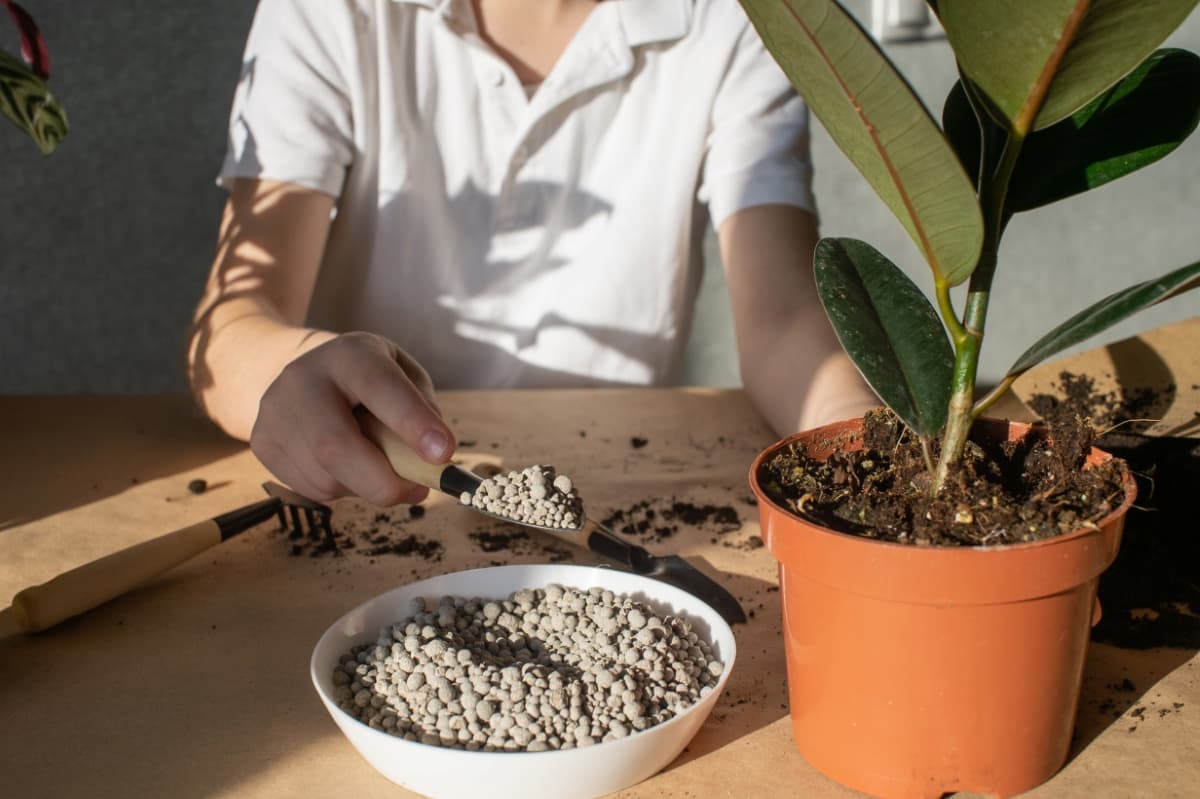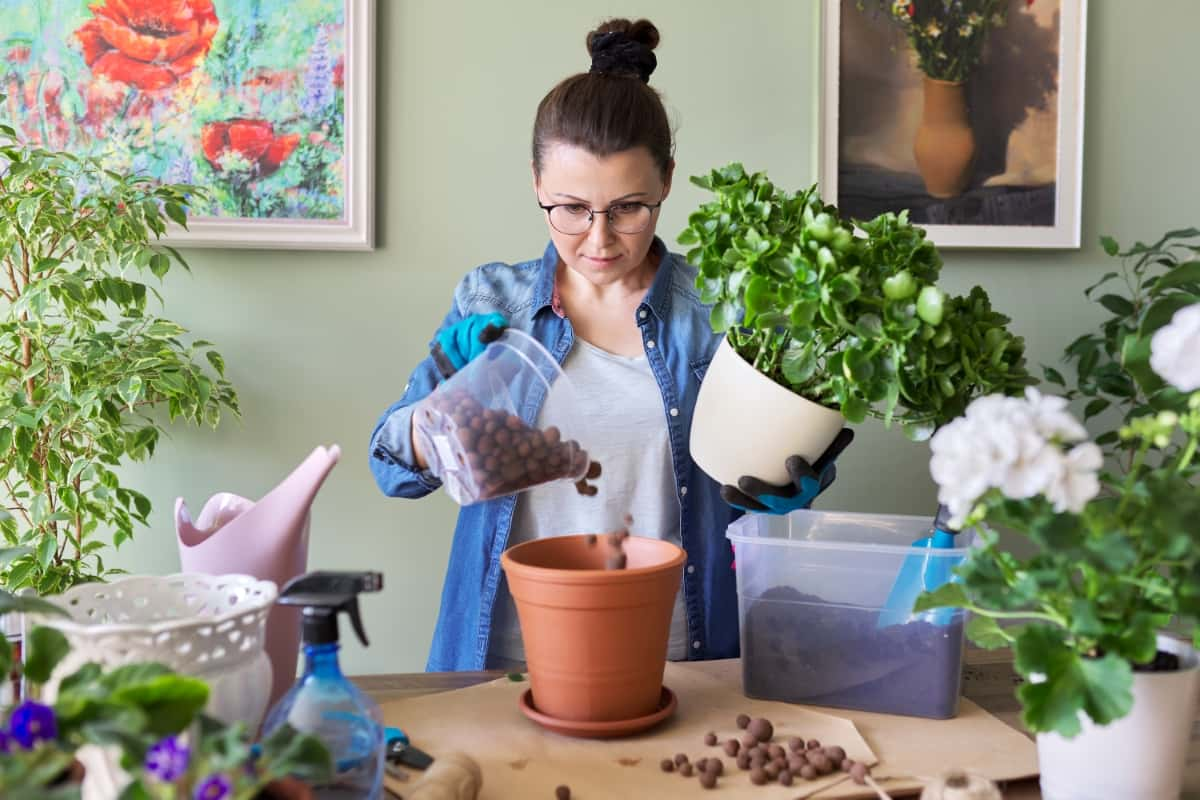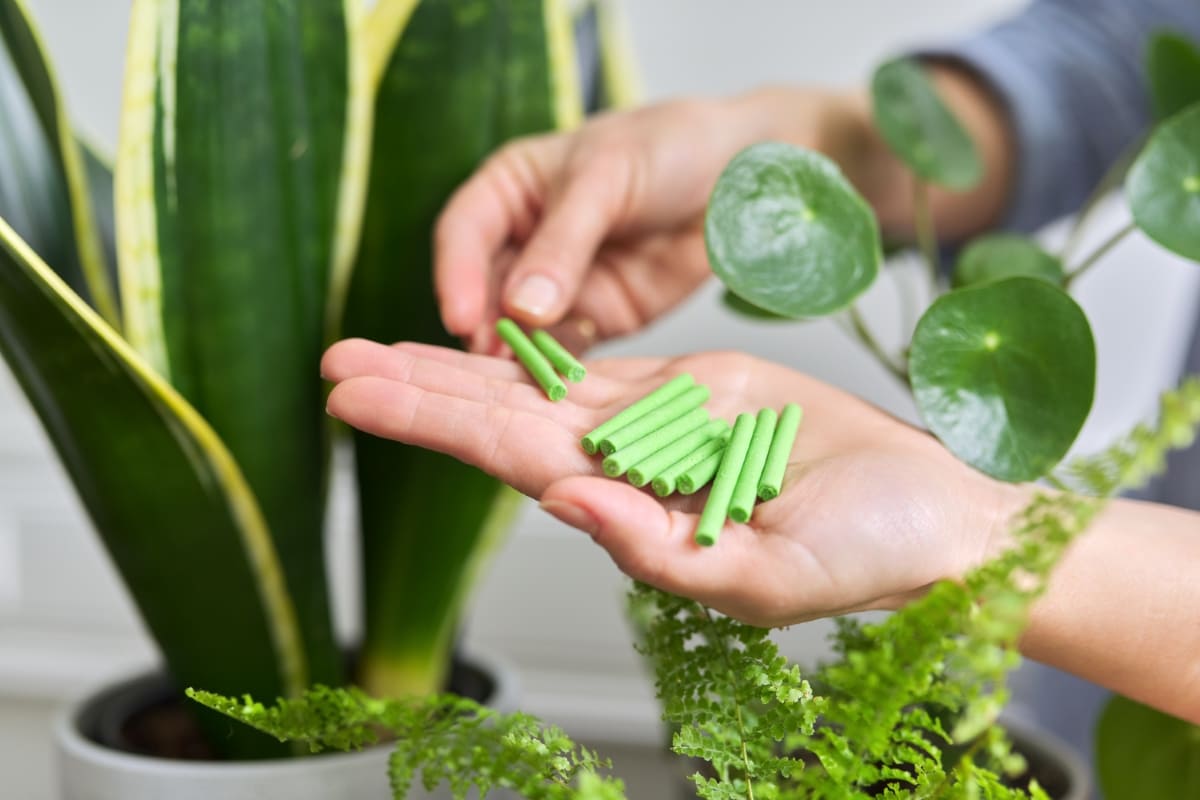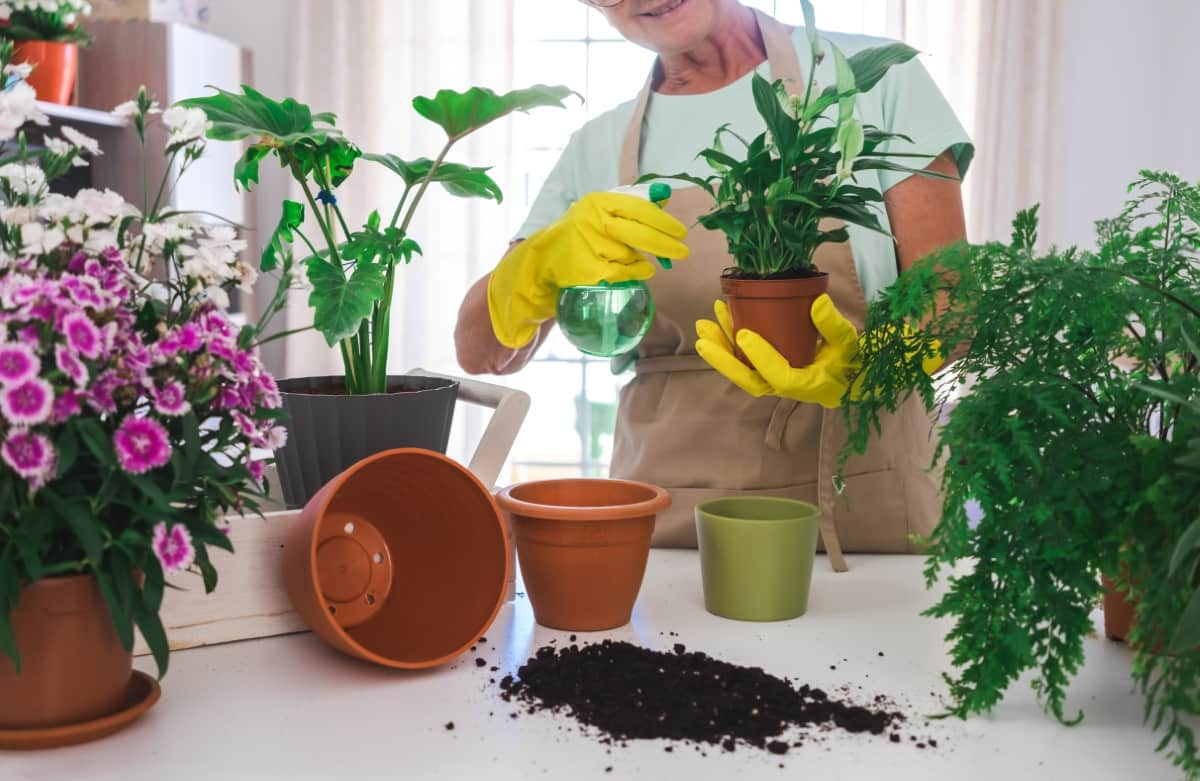Understanding the optimal N-P-K ratio for indoor plants is crucial for anyone looking to enhance their indoor garden’s health, growth, and bloom. N-P-K stands for Nitrogen, Phosphorus, and Potassium, the three primary nutrients required for the healthy development of plants. Each element serves a unique purpose: Nitrogen promotes lush foliage, Phosphorus is essential for root development and flowering, and Potassium ensures overall plant vitality.
A balanced fertilizer for indoor flora, whether organic or synthetic, can significantly impact plant vigor by providing these essential nutrients in the right proportions. This guide on indoor plant fertilization explores optimal N-P-K ratios, fertilization methods, and the merits of organic versus synthetic fertilizers to promote robust growth for your indoor plants.
Understanding the Basics of N-P-K
N-P-K for indoor plants represents the foundational elements of plant nutrition, with each letter symbolizing a key nutrient: Nitrogen (N), Phosphorus (P), and Potassium (K). These elements are critical for various plant functions, from leaf production to root growth and overall health. The N-P-K ratio on fertilizer packages indicates the proportion of each nutrient, guiding gardeners in selecting the best fertilizer for indoor plants. Understanding these ratios is essential for applying precision fertilization for indoor plants, ensuring each plant receives the nutrients it needs to thrive.
Why N-P-K Ratios Matter for Indoor Plants
Optimal N-P-K ratios are paramount for enhancing indoor plant health as they directly influence growth, vitality, and blooming. For instance, leafy greens may thrive with a higher Nitrogen concentration, often requiring ratios like 3-1-2, while flowering plants might benefit more from increased Phosphorus levels, with ratios such as 1-2-1.

Succulents and cacti, preferring low-nutrient environments, do well with minimal fertilization, often in ratios 1-1-1 or even less. These numbers help craft a balanced fertilizer for indoor flora tailored to the specific needs of each plant type, ensuring optimal growth and health.
NPK Ratio for Your Indoor Plants
The Science Behind N-P-K Ratios
Nitrogen (N): Foliage and Growth
Nitrogen is pivotal for the growth of lush, green foliage in indoor plants, acting as a primary component of chlorophyll, essential for photosynthesis. A higher nitrogen level in the N-P-K fertilization techniques supports vigorous leaf development, making nitrogen a key nutrient for plants like ferns and leafy greens prized for their foliage. However, an excess can lead to rapid growth at the expense of flowering and root development, underscoring the importance of balanced fertilization.
Phosphorus (P): Root Development and Flowering
Phosphorus is vital for root development, flowering, and energy transfer in indoor plants, crucial for their overall growth and well-being. It supports the formation of strong root systems and helps develop buds and flowers, making it particularly important for blooming plants. The right phosphorus levels can enhance the quality and longevity of blooms, contributing to the aesthetic appeal of flowering indoor plants.
Potassium (K): Plant Health and Disease Resistance
Potassium is key to overall plant health, aiding in water uptake, enzyme activation, and disease resistance. It helps plants withstand stress, including diseases, pests, and varying light conditions, making it crucial for the vitality of indoor plants. A suitable potassium level in the N-P-K ratio ensures that plants have strong cellular structures and improved physiological processes, leading to healthier and more resilient indoor gardens.
Ideal N-P-K Ratios for Common Indoor Plants
Ratios for Leafy Greens vs. Flowering Plants
Leafy greens typically require a higher nitrogen content to support their foliage growth, with ideal N-P-K ratios around 3-1-2. In contrast, flowering plants need more phosphorus to encourage bloom production, making ratios like 1-2-1 more suitable. These nutrient ratios for potted plants are essential for tailoring fertilization practices to the specific needs of each plant type, ensuring they receive the right nutrition for their growth stages and functions.
Customizing Nutrition for Succulents and Cacti
Succulents and cacti require minimal fertilization compared to other indoor plants, thriving in low-nutrient environments. An N-P-K ratio of 1-1-1 or lower is often sufficient for these plants, providing enough nutrients to support their slow growth without overwhelming them. Adjusting N-P-K for plant stages, especially for low-nutrient-requiring plants like succulents, is crucial for maintaining their health without promoting excessive growth that can weaken the plant.
Organic Versus Synthetic Fertilizers
Pros and Cons of Organic N-P-K Sources
Organic indoor plant fertilizer N-P-K sources, such as compost, manure, and bone meal, offer a sustainable and environmentally friendly option for plant nutrition. These organic materials release nutrients slowly, improving soil structure and microbial activity, which benefits plant health in the long term. However, the nutrient ratios in organic fertilizers can be less precise than synthetic options, making it harder to provide specific nutrient adjustments.
When to Choose Synthetic Fertilizers for Indoor Plants
Synthetic fertilizers quickly and precisely deliver essential nutrients to indoor plants with clearly labeled N-P-K ratios allowing targeted nutrition. They are especially useful when plants show nutrient deficiencies that require immediate correction. However, synthetic fertilizers can lead to salt buildup in the soil and do not improve soil health over time, which is why they should be used judiciously, considering the long-term health of indoor plants.
In case you missed it: How to Make Homemade Fertilizer for Polyhouse Crops: A Comprehensive Guide for Beginners

How to Apply N-P-K Fertilizers
Proper Timing for Fertilization
The timing of N-P-K application for indoor gardening is critical for plant health and productivity. Fertilizing in spring and summer promotes plant growth, while refraining from fertilization in fall and winter allows plants to undergo a period of dormancy. Seasonal fertilizer adjustments for indoor plants ensure they receive nutrients at the right time, promoting healthy growth cycles.
Techniques for Even Application
Even applying N-P-K fertilizers ensures that all parts of the plant’s root system access essential nutrients. Techniques such as diluting liquid fertilizers or evenly spreading granular fertilizers across the soil surface help prevent nutrient burn and promote uniform plant growth. Precision in applying fertilizers, considering each plant’s specific needs and growth patterns, is key to maximizing their health and vitality.
Adjusting N-P-K Ratios for Plant Life Stages
Seedlings and Young Plants
Seedlings and young plants have delicate nutrient needs, often requiring a balanced N-P-K ratio to support their initial growth without overwhelming their developing systems. A gentle fertilizer solution, slightly higher in phosphorus, can encourage root growth and help young plants establish themselves.
Mature Plants and Repotting Needs
As indoor plants mature, their nutritional requirements change, often needing a shift in the N-P-K ratio to support continued growth, flowering, or fruiting. Additionally, repotting provides an opportunity to refresh the soil and adjust the fertilizer blend to suit the plant’s current growth stage and condition, ensuring ongoing vitality and productivity.
Monitoring and Adjusting N-P-K Based on Plant Health
Signs of Nutrient Deficiency
Signs of nutrient deficiency in indoor plants include yellowing leaves for nitrogen shortage, weak root systems for phosphorus deficiency, and brown edges on leaves signaling a lack of potassium. Recognizing these signs early allows for timely adjustments to the N-P-K fertilization regimen, ensuring plants receive the nutrients they need to recover and thrive.
Correcting Nutrient Imbalances
Correcting nutrient imbalances involves adjusting the N-P-K ratios in your fertilization approach based on the specific deficiencies observed in your plants. This might mean increasing nitrogen for plants with stunted growth or adding phosphorus-rich fertilizer for those struggling to bloom. Precision fertilization for indoor plants, tailored to their current health and nutrient needs, is key to restoring their vigor.
DIY Fertilizer Mixes for Optimal N-P-K Ratios
Homemade Compost and Liquid Fertilizers
Homemade compost and liquid fertilizers can be excellent sources of balanced nutrition for indoor plants, providing a natural and cost-effective way to deliver essential nutrients. For instance, compost teas or liquid seaweed solutions can offer a gentle N-P-K ratio of around 1-1-1, suitable for various indoor plants and beneficial for promoting healthy soil microbiota.
Using Natural Ingredients for Balanced Nutrition
Natural ingredients like coffee grounds, banana peels, and eggshells can create DIY fertilizer mixes that provide balanced N-P-K nutrition. For instance, banana peels contain ample potassium, eggshells provide calcium with a hint of phosphorus, and coffee grounds contribute nitrogen. These materials can be effectively utilized to create targeted nutrient amendments or a versatile indoor plant fertilizer.
In case you missed it: Maximize Blooms: The Best NPK Ratio for Flowering Plants Explained

Watering Practices with N-P-K Fertilization
Importance of Water in Nutrient Absorption
Water is essential for facilitating nutrient absorption by transporting dissolved nutrients from the soil to the plant’s roots. Proper watering ensures that fertilizers are adequately dissolved and available to the plants, facilitating optimal nutrient uptake and preventing the accumulation of unused fertilizers in the soil.
Avoiding Over-Watering and Nutrient Leach
Excessive watering can result in nutrient leaching, causing vital nutrients to be washed away from the root area before plants can uptake them, ultimately resulting in nutrient deficiencies and compromised plant vitality. Maintaining a balanced watering schedule that meets your indoor plants’ needs without saturating the soil is vital for effective N-P-K fertilization and overall plant well-being.
In case you missed it: Boost Your Harvest: Expert Guide to NPK Ratios for Vegetable Gardening

Conclusion
Understanding and managing the N-P-K ratios for indoor plants is foundational to their health and growth, requiring careful monitoring of plant health, timely adjustments to fertilization, and appropriate watering practices. DIY fertilizer mixes offer an eco-friendly option for providing balanced nutrition while recognizing and correcting nutrient imbalances to ensure that indoor plants remain vibrant and flourishing. Through attentive care and tailored nutrition, gardeners can foster a thriving indoor garden that brings beauty and vitality to any space.
- Feed Your Flock for Less: Top 10 Tips to Save on Chicken Feed
- Ultimate Guide to Ossabaw Island Hog: Breeding, Raising, Diet, and Care
- Hatching Answers: The Top 10 Reasons Your Chickens Aren’t Laying Eggs
- Eggs and Economics: Breaking Down the Cost of Raising Backyard Chickens
- Defend Your Greens: Proven Methods to Keep Iguanas Out of Your Garden
- Ultimate Guide to Cinnamon Queen Chicken: A Comprehensive Guide for Beginners
- Ultimate Guide to California Tan Chicken: Breeding, Raising, Diet, Egg-Production and Care
- Ultimate Guide to Marsh Daisy Chicken: Breeding, Raising, Diet, and Care
- 10 Types of Chicken Farming Businesses You Can Start for Profits